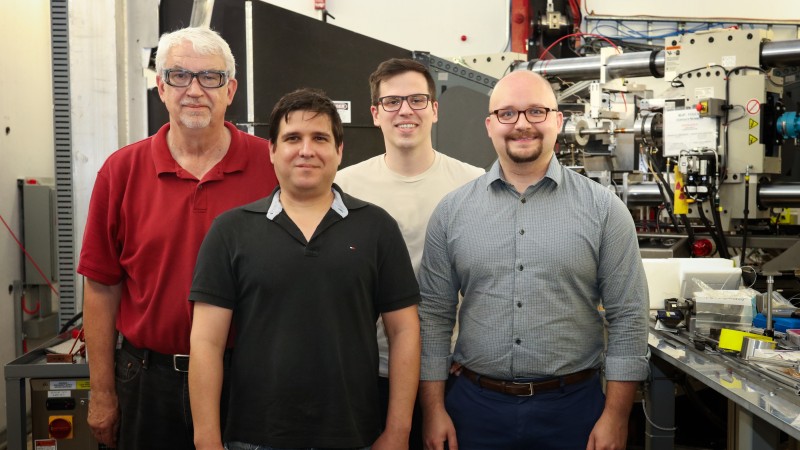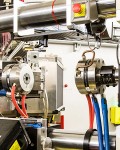Heat resistant. Corrosion resistant. Castable. Lighter. Stronger. Stiffer. More flexible. When the properties and functionality of high-performance aluminum alloys are increased, so too is their market demand.
For competitors, gaining the upper hand could ultimately be determined by how well they understand their manufacturing materials at the atomic scale and how quickly they can incorporate research and development insights into new production designs.
By partnering with the Department of Energy’s (DOE’s) Oak Ridge National Laboratory (ORNL), Eck Industries Inc. is doing just that—developing aluminum alloys and bringing them quickly to market. The partnership, through DOE’s Critical Materials Institute, has already led to the co-development and exclusive licensing of a cerium-aluminum alloy that won an R&D 100 Award and a 2018 Federal Laboratory Consortium Award. Now, the aluminum casting company is looking to unlock even more functionality from the alloy through rigorous testing using neutrons at ORNL’s Spallation Neutron Source (SNS).
“The basic aluminum-cerium system has many possible variations depending on what other alloying elements you add to the material, so we’re using neutrons to study what the effects of those elements are going to be on the material’s mechanical properties,” said David Weiss, vice president of engineering and research and development at Eck Industries. “If we can understand the mechanical behavior of the material better, we’ll be able to design better alloys.”
Iterations of the “superalloy” are already in production, says Weiss, from high-performance racing pistons and cylinder heads for diesel engines to turbine blades for hydroelectric power applications.
“Our alloy has a high threshold for heat. By adding cerium, the alloy is stable all the way up to its melting point. How much cerium we add determines how strong the alloy is at higher temperatures,” said Weiss.
For example, Eck is working with a company that builds twin-turbine hydroelectric generators. Because of the client’s complicated blade design, using heat treatments during manufacturing would distort the final product, says Weiss. If Eck can develop an alloy with high castability that doesn’t require heat treatments, it would result in a higher-performance blade as well as save the manufacturers up to 50 percent on their energy costs.
More so than x-rays, neutrons are deeply penetrating even through dense metals. When neutrons scatter off atoms in a material, they provide researchers with a wealth of structural information down to the atomic scale.
Using the VULCAN instrument, Weiss and the ORNL staff can investigate how the alloys are performing under simulated real-world operating conditions and beyond, such as high heat and extreme stress or tension, to identify even the smallest defects or breakdowns.
“There are a lot of reasons to use neutrons, but in this case, it allows us to see the diffraction from the individual phases and allows us to do it in a volume that’s meaningful to an engineering material,” said ORNL materials scientist Orlando Rios. “If we were to run this experiment with x-rays—and we have—we’d only be able to measure the surface.”
Weiss added that neutrons allow them to bypass surface structures or minute defects that form during the manufacturing solidification process to investigate mechanical properties deep within the alloy. Furthermore, neutrons' deeply penetrating capabilities enable the use of large sample sizes that are representative of the actual castings produced in the foundry. Measuring the materials' properties and the behavior of atoms under load translates directly to engineering components.
“We have a unique partnership here. Developing new materials is an exacting practice, and the ability to transition from theory one day to experiment the next day and characterization the day after is extremely important. We’ve gone through 50 to 60 different alloys and have promising new ways to move forward with some of them,” said Weiss. “It helped us take a basic alloy system from concept—literally using napkin sketches Orlando and I created—into a production part in two years.
“To give our customers the exact technical solutions they’re looking for is only possible with this kind of industry–lab partnership. It’s the only way it can be done.”
This work is being supported by the Critical Materials Institute, a DOE Energy Innovation Hub funded by DOE’s Office of Energy Efficiency and Renewable Energy’s Advanced Manufacturing Office. CMI seeks ways to eliminate and reduce reliance on rare-earth metals and other materials critical to the success of clean energy technologies.
SNS is a DOE Office of Science User Facility. UT-Battelle LLC manages ORNL for DOE’s Office of Science. The Office of Science is the single largest supporter of basic research in the physical sciences in the United States and is working to address some of the most pressing challenges of our time. For more information, please visit http://science.energy.gov/.—by Jeremy Rumsey








